by Venchito Tampon Jr | Last Updated on July 5, 2023
You, too, have done it – you’ve probably searched your brand name or the product you sell to see what comes up on the first page of Google. There will be results from your website, but there is also something else – a box with information about your brand or product.
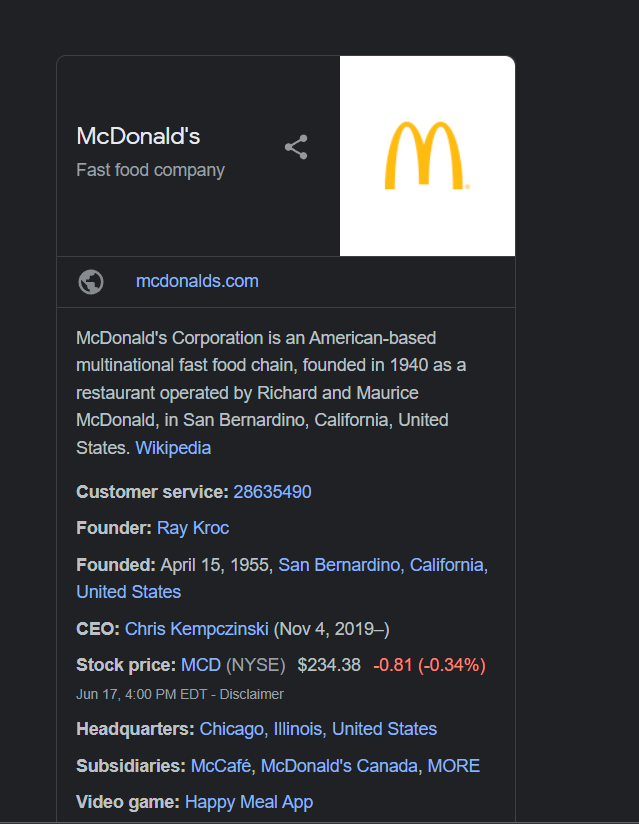
So if you’ve seen it, you’ve experienced the power of the Knowledge Graph.
What is a knowledge graph SEO?
A knowledge graph in SEO refers to Google’s vast database that enhances its understanding of search queries and enables it to offer direct answers in search results. The knowledge panel is the primary way information from the knowledge graph appears, providing key takeaways and insights to users.
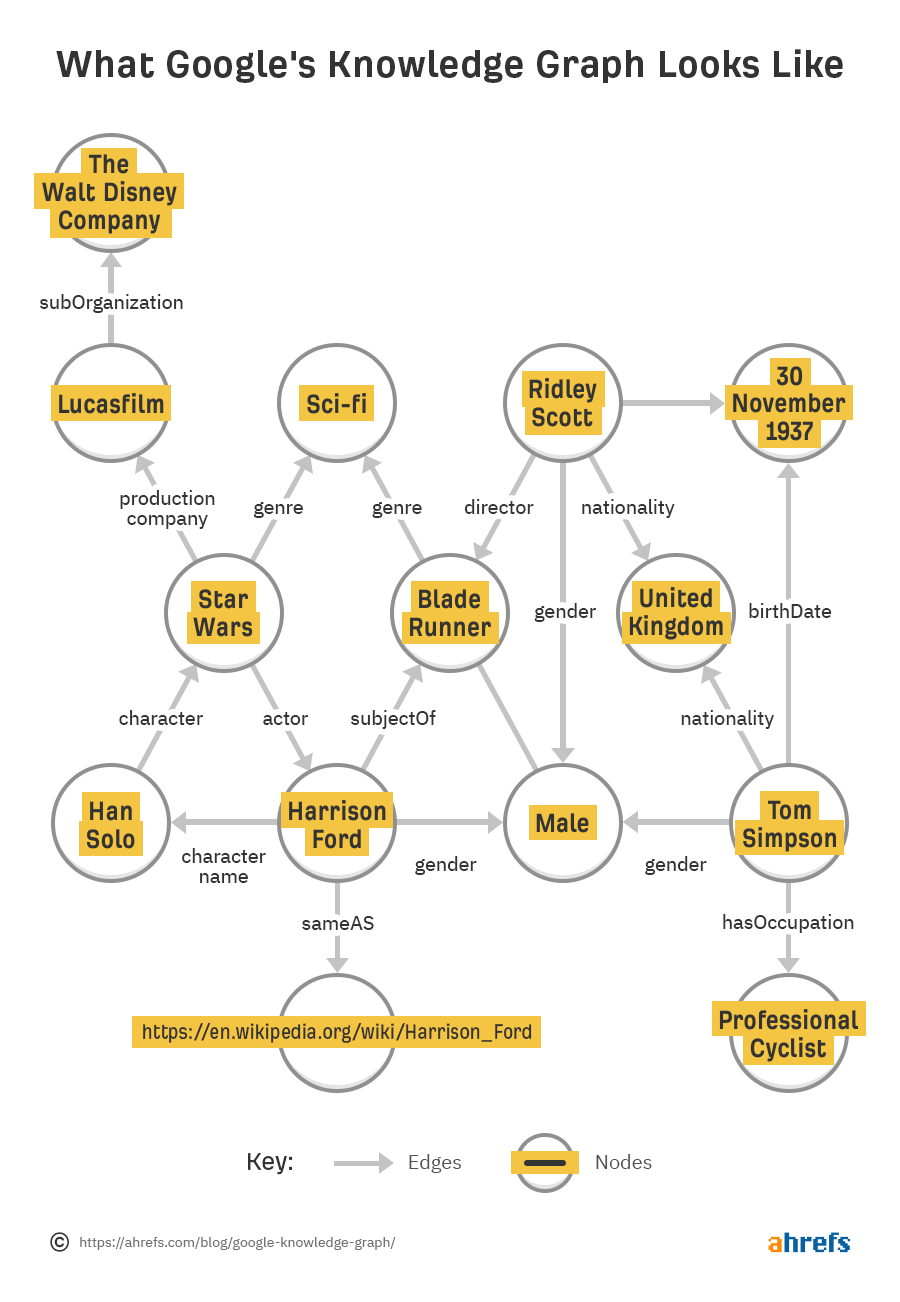 Source: https://ahrefs.com/blog/google-knowledge-graph/
Source: https://ahrefs.com/blog/google-knowledge-graph/
The Knowledge Graph is the box of information that appears on the right-hand side of the screen when you perform a Google search of your brand. It includes things like:
- Brand name
- Logo
- Founded date
- Phone number(s)
- Founders
- Address
- Team Management
- Social media profiles
- What people also search for
Or if it’s a person, you’ll see:
- Birthdate
- Place of birth
- Education
- Spouse
- Occupation
- Citizenship
And if it’s a store or a location, you’ll see:
- Opening hours
- Address
- Phone number
- Ratings
- Map
- Photos
You may have also noticed that the Knowledge Graph appears in other places, such as on Google Maps.
The Knowledge Graph box appears when you search for a business on Google Maps. The information is pulled from the business’s Google My Business listing.
What Impact Does It Have On SEO?
Google says its goal with the Knowledge Graph is to “Go beyond keyword matching to understand the people, places, and things you care about, and deliver them straight to you.”
They want to provide searchers with the information they are looking for without having to click through to a website. This is great news for SEOs! We no longer have to rely on getting that coveted first organic result to get our brand in front of searchers.
The Knowledge Graph is also great for voice search. With the increasing popularity of voice assistants like Amazon Echo and Google Home, searchers use natural language to ask questions. This is where the Knowledge Graph can shine.
Google can use the information in the Knowledge Graph to answer a searcher’s question directly, without the need to click through to a website.
For example, if someone asks their Google Home, “What is the founder of Tesla?” Google can answer that question using the information in our Knowledge Graph listing.
What’s the Difference Between Google’s Knowledge Graph, Rich Results, and Featured Snippets?
Google’s Knowledge Graph is not the only structured data that can appear in search results. Google also uses “rich results” to enhance the search experience.
Rich results are similar to the Knowledge Graph, but they are generated from the content on your website. They can include things like:
- Ratings and reviews
- Pricing
- Events
- Ingredients
- People
- Products
Rich results can appear in both mobile and desktop search results. They are generated from the structured data on your website using schema.org markup.
Schema.org is a collaborative project between Google, Microsoft, Yahoo, and Yandex to help structure data on the web.
You can see an example of rich results in the search results for a recipe. The recipe title, photo, rating, and cook time are all generated from structured data on the website.
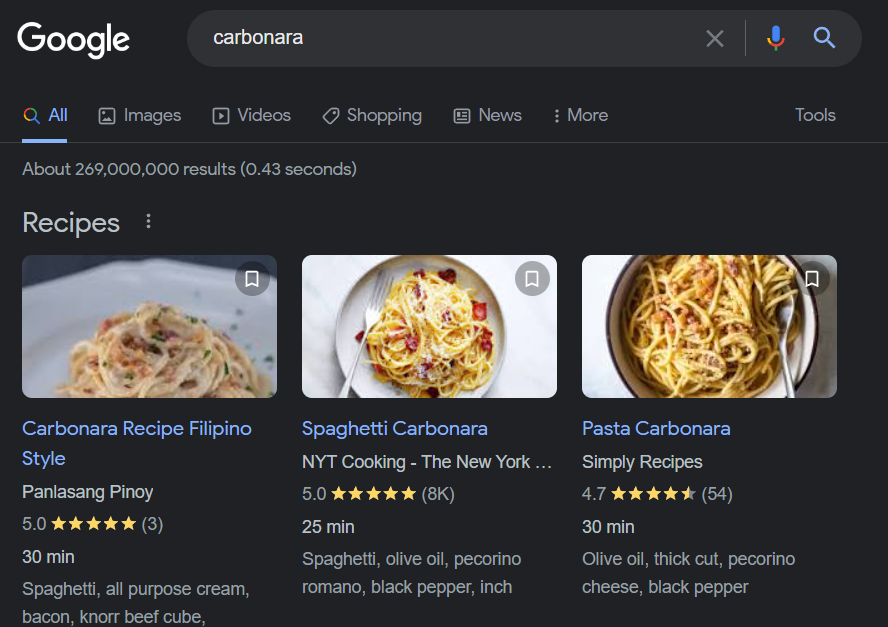
Google also uses “featured snippets” to answer searchers’ questions directly. Featured snippets are generated from the content on your website.
Google pulls a snippet of text from your website and displays it in the search results. They also display the URL of the page where they found the information.
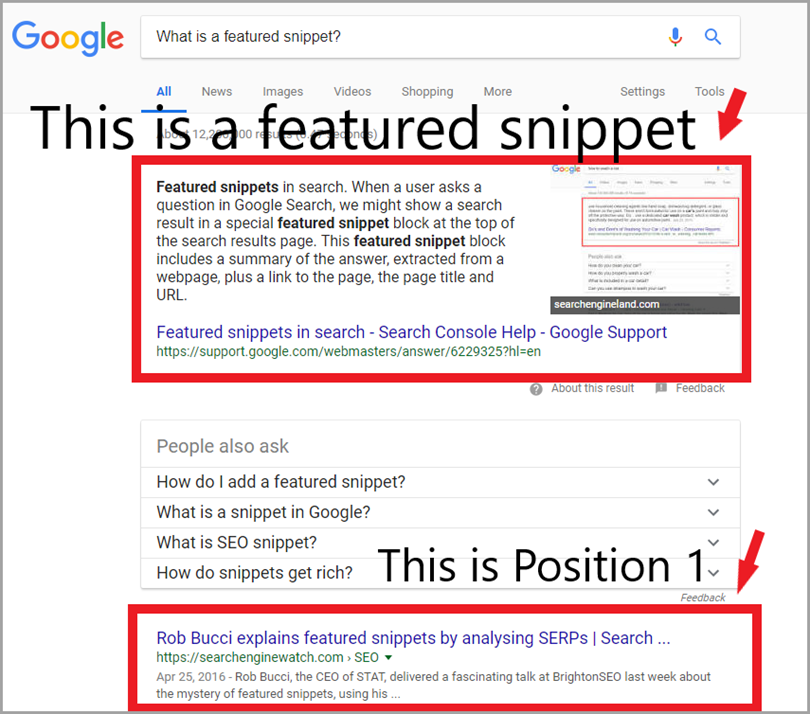
Featured snippets differ from rich results because they are not generated from structured data. They are also different from the Knowledge Graph because they are not Google’s own database of information.
How to Optimize Your Knowledge Graph Listing
Now that we’ve talked about the benefits of optimizing your Knowledge Graph listing let’s talk about how you can do it.
There are a few things you can do to make sure your Knowledge Graph listing is optimized for SEO:
- Claim your Google My Business listing
- Optimize your NAP (Name, Address, Phone number)
- Add images and videos
- Add business category
- Encourage customer reviews
- Use structured data markup
- Optimize your website content
Let’s take a closer look at each of these optimization tips.
1. Claim Your Google My Business Listing
The first step to optimizing your Knowledge Graph listing is to claim your Google My Business listing.
If you haven’t claimed your listing yet, you can do so by going to google.com/business.
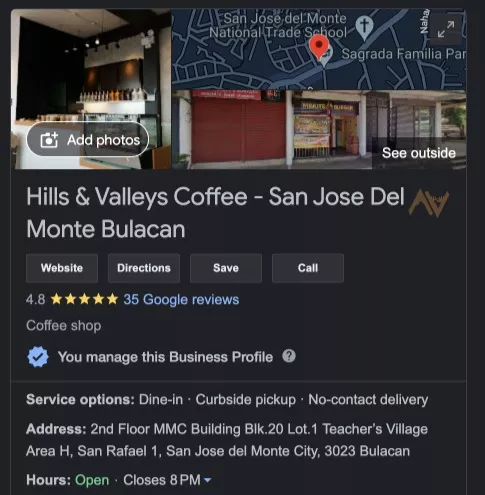
Once you’ve claimed your listing, you can add information about your business, such as your NAP, business hours, website URL, and more.
You’ll also be able to upload images and videos, which we’ll discuss in the next section.
2. Optimize Your NAP
The second step to optimizing your Knowledge Graph listing is to optimize your NAP.
Your NAP is your name, address, and phone number. It’s important to ensure your NAP is consistent across the web.
That means if you have a different phone number on your website than you do on your Google My Business listing, it will confuse Google.
To avoid this, ensure your NAP is the same on all your online listings.
3. Add Images and Videos
Adding images and videos is the third step to optimizing your Knowledge Graph listing.
Google loves visual content, so adding images and videos is a great way to improve your listing.
Not only will this help your listing stand out, but it will also give Google more information about your business.
To add images, simply go to your Google My Business listing and click on the “photos” tab. From there, you can upload photos of your business, employees, products, etc.
To add videos, you’ll need first to upload them to YouTube. Once uploaded, you can add them to your Google My Business listing by going to the “photos” tab and clicking on the “add video” button.
4. Add Business Category
The fourth step to optimizing your Knowledge Graph listing is to add a business category.
Adding a business category is a great way to help Google understand what your business is all about.
To add a business category, simply go to your Google My Business listing and click on the “info” tab. From there, you can scroll down to the “category” section and add a business category.
5. Encourage Customer Reviews
The fifth step to optimizing your Knowledge Graph listing is encouraging customer reviews.
Customer reviews are a great way to show Google that your business is reputable and trustworthy.
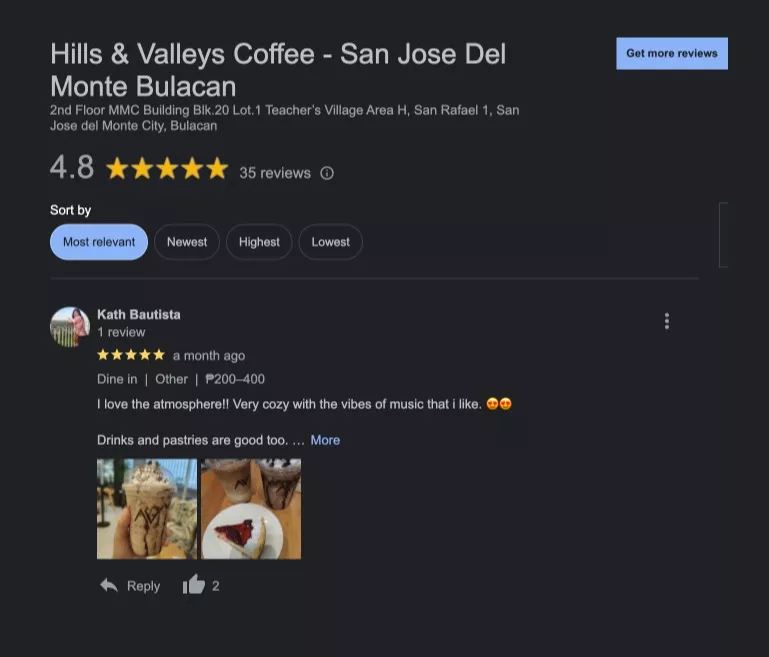
To encourage customer reviews, go to your Google My Business listing and click the “reviews” tab. From there, you can post a message asking customers to leave a review.
You can also post a link to your review page on your website or send it out in an email blast.
6. Use Structured Data Markup
The sixth step to optimizing your Knowledge Graph listing is to use structured data markup.
Structured data markup is code you can add to your website to give Google more information about your business.
Adding structured data markup is a great way to improve the chances of your listing appearing in the Knowledge Graph.
To add structured data markup, you’ll need to edit the code of your website. If you’re not comfortable doing this, you can hire a developer to do it for you.
You can customize your brand’s Knowledge panel by:
- Optimizing logo structured data – Add code to your website that tells Google about your logo.
- Adding social profile links – You can add links to your business’s social media profiles so people can find you on Facebook, Twitter, etc.
- Adding company contact numbers – You can add your business’s phone number and email address so people can contact you.
- Adding holiday hours – You can add your business’s holiday hours so people know when you’re closed.
- Adding links to important pages – You can add links to your website’s most important pages, such as your About Us page, Services page, etc.
7. Optimize Your Website Content
The seventh and final step to optimizing your Knowledge Graph listing is to optimize your website content.
Google crawls your website to determine what your business is all about.
If your website is poorly designed or doesn’t have much content, it will be difficult for Google to understand what your business is all about.
To optimize your website content, start by ensuring that your website is well-designed and easy to navigate.
Then, ensure that your website has a lot of relevant content to your business.
The more content you have, the easier it will be for Google to understand your business.
If you’re unsure how to optimize your website content, you can hire an agency that does local SEO services.
Takeaway
The Knowledge Graph is a powerful tool that can help you get more exposure for your business. If you’re not already using it, now is the time to start.
By following the seven steps outlined in this article, you can optimize your Knowledge Graph listing and improve your chances of appearing in the Knowledge Graph.
Knowledge Graph Optimization FAQs
How do you optimize a knowledge graph?
To optimize a knowledge graph for SEO, start by ensuring that your entity’s information is accurate and comprehensive. Use Schema markup to provide search engines with structured data about your entity. Focus on building strong online authority through high-quality backlinks and content. Regularly update and verify your entity’s information to maintain its relevancy and accuracy. Monitor and analyze your knowledge graph’s performance to identify areas for improvement and make adjustments accordingly.
How to use knowledge graph for SEO?
To leverage Google’s Knowledge Graph for SEO, focus on optimizing your website with structured data markup, semantic markup, and relevant content. Implement Schema.org markup to help Google understand your website’s entity and relational information. Improve your website’s authority and relevance by earning quality backlinks and creating engaging content. Regularly update and optimize your website to enhance its chances of appearing in the Knowledge Graph.
Does Google still use knowledge graph?
Yes, Google still uses Knowledge Graph to display information in search results. Knowledge Graph is a vast database of billions of facts about various entities like people, places, and things. It helps provide relevant and accurate information to users directly within the search results.
What are the benefits of Google’s knowledge graph?
Some benefits of Google’s Knowledge Graph include:
1. It helps you get more exposure for your business.
With the knowledge graph, you’re increasing your chances of appearing in Google’s search results. And, as we all know, the higher you appear in Google’s search results, the more traffic you’re likely to get.
2. It helps you build trust and credibility with potential customers.
When potential customers see your business listed in the knowledge graph, they’re more likely to trust and do business with you. After all, if Google trusts you enough to list you in their knowledge graph, you must be a pretty reputable business.
3. It helps you stand out from your competition.
If your competition isn’t using the knowledge graph, you can really stand out. This is especially true if you’re in a competitive industry.
4. It’s free exposure for your business.
Unlike paid advertising, the knowledge graph is completely free. So, if you can get your business listed in the knowledge graph, it’s essentially like getting free advertising.
5. It can help you generate leads and sales.
If potential customers see your business listed in the knowledge graph, they’re more likely to contact and do business with you. In other words, the knowledge graph can help you generate leads and sales.
How to display an e-commerce knowledge graph?
You can do a few things to help Google display your e-commerce business in the knowledge graph.
1. Make sure your website is well-designed and easy to navigate.
This will help Google understand what your eCommerce site provides and make it easier for them to crawl it.
2. Add structured data to your website.
Adding structured data to your website will help Google understand your site’s content and make it easier for them to display your business in the knowledge graph.
3. Add content to your website.
The more content you have on your website, the easier it will be for Google to understand your business.
4. Optimize your website for search engines.
Ensure you’re using the right keywords and phrases on your website so that Google can easily find and index your site.
5. Promote your website online.
The more people visiting your site, the more likely it is that Google will notice and display your business in the knowledge graph.
How does Google’s algorithm determine what displays in the knowledge graph?
Google’s algorithm looks at various factors to determine what displays in the knowledge graph.
1. Relevance
Google will only display information relevant to the user’s search query in the knowledge graph.
2. Sources
Google looks at various sources to determine what information to display in the knowledge graph. These sources include websites, news articles, and more.
3. Authority
Google looks at the authority of the sources to determine which information to display in the knowledge graph. The more authoritative a source is, the more likely Google will display its information in the knowledge graph.
4. Accuracy
Google also looks at the accuracy of the information to determine what to display in the knowledge graph. Inaccurate information is less likely to be displayed in the knowledge graph.
5. Freshness
Google prefers to display fresh, up-to-date information in the knowledge graph. So, if you want your business to be displayed in the knowledge graph, keeping your website and information up-to-date is important.
How to get certain photos to show in knowledge graph listing?
You can update your knowledge graph listing by adding photos and other information about your business. Here are a few things you can do to get certain photos to show up in your knowledge graph listing:
1. Add photos to your website.
Google will pull out any photos related to your business from your website and display them in the knowledge graph. So, if you want certain photos to show up, add them to your website.
2. Add photos to your Google My Business listing.
If you have a Google My Business listing, you can add photos to it. This will help Google understand what your business looks like and make certain photos more likely to appear in the knowledge graph.
3. Suggest a change to Google Knowledge Listing
If you see that Google has incorrect information or photos listed for your business, you can suggest a change on the listing. Google will then review your suggestion and make the appropriate changes.
Read this guide for more information.
How long does Google knowledge graph take to update?
Google doesn’t have an exact timeframe for when the knowledge graph will be updated. However, it’s generally a good idea to wait at least a few weeks before you expect to see any changes.
If you’ve made changes to your website or Google My Business listing, you can try resubmitting your sitemap to Google to help speed up the process.
When was Google knowledge graph introduced?
Google knowledge graph was introduced on May 16, 2012.
How to get your address in google knowledge graph without submitting street address?
There is no guaranteed way to get your address in the knowledge graph without submitting your street address. However, there are a few things you can do to increase the chances of your address being displayed:
1. Add your address to your website.
Ensure you add your full address (including your street address) to your website. Google will use this information to determine whether or not to display your address in the knowledge graph.
2. Add your address to your Google My Business listing.
If you have a Google My Business listing, add your full address to it. This will help Google understand that your business is located at that address and make it more likely for your address to be displayed in the knowledge graph.
3. Suggest a change to Google Knowledge Listing
If you see that Google has incorrect information or photos listed for your business, you can suggest a change on the listing. Google will then review your suggestion and make the appropriate changes.
The Author
Venchito Tampon Jr
Venchito Tampon is a Filipino Motivational Speaker, Corporate Trainer, and a Leadership Speaker in the Philippines. He is the CEO and Co-Founder of SharpRocket, a link building agency. With a decade of experience, Venchito has a proven track record of leading hundreds of successful SEO (link builidng) campaigns across competitive industries like finance, B2B, legal, and SaaS. His expert advice as a link building expert has been featured in renowned publications such as Semrush, Ahrefs, Huffington Post and Forbes. He is also an international SEO spoken and has delivered talks in SEO Zraz, Asia Pacific Affiliate Summit in Singapore, and Search Marketing Summit in Sydney, Australia. Check out his other businesses, Hills & Valleys Cafe, Blend N Sips and Saas Pursuit.
How our LINK BUILDING AGENCY builds 250 links/mo consistently using Predictable Link Building Methodology™…
- Using a SIMPLE and PROVEN system
- Using a SCALABLE strategy
- No private blog networks
- No creepy outreach emails
